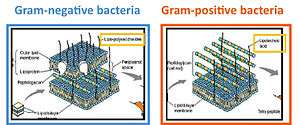Lipoteichoic acid
Lipoteichoic acid (LTA) is a major constituent of the cell wall of gram-positive bacteria. These organisms have an inner (or cytoplasmic) membrane and, external to it, a thick (up to 80 nanometer) peptidoglycan layer. The structure of LTA varies between the different species of Gram positive bacteria and may contain long chains of ribitol or glycerol phosphate. LTA is anchored to the cell membrane via a diacylglycerol.[1] It acts as regulator of autolytic wall enzymes (muramidases). It has antigenic properties being able to stimulate specific immune response and is released from the bacterial cells mainly after bacteriolysis induced by lysozyme, cationic peptides from leucocytes, or beta-lactam antibiotics.

LTA may bind to target cells non-specifically through membrane phospholipids, or specifically to CD14 and to Toll-like receptors. Binding to TLR-2 has shown to induce NF-κB expression(a central transcription factor), elevating expression of both pro- and anti-apoptotic genes. Its activation also induces mitogen-activated protein kinases (MAPK) activation along with Phosphoinositide 3-kinase activation.
LTA bound to targets can interact with circulating antibodies and activate the complement cascade to induce a passive immune kill phenomenon. It also triggers the release from neutrophils and macrophages of reactive oxygen and nitrogen species, acid hydrolases, highly cationic proteinases, bactericidal cationic peptides, growth factors, and cytotoxic cytokines, which may act in synergy to amplify cell damage. Therefore, LTA shares many pathogenic similarities with endotoxins (lipopolysaccharide).
Studies

In animal studies, LTA has induced arthritis, nephritis, uveitis, encephalomyelitis, meningitis, and periodontal lesions, and also triggered cascades resulting in septic shock and multiorgan failure. Binding of LTA to targets can be inhibited by phospholipids and antibodies directed at LTA, CD14, or Toll-like receptors. In vitro, LTA release can be inhibited by non-bacteriolytic antibiotics and by polysulfates such as heparin.
LTA can be considered a virulence factor that has an important role in infections and in postinfectious sequelae caused by Gram-positive bacteria. The development of effective antibiotics killing the bacteria without lysing them and multidrug strategies to attenuate LTA-induced secretion of proinflammatory agonists is of great importance to combat septic shock and multiorgan failure caused by Gram-positive bacteria.
LTA's molecular structure has been found to have the strongest hydrophobic bonds of an entire bacteria.
Said et al. showed that LTA causes an IL-10-dependent inhibition of CD4 T-cell expansion and function by up-regulating PD-1 levels on monocytes which leads to IL-10 production by monocytes after binding of PD-1 by PD-L.[2]
References
- ↑ KP Talaro Foundations in Microbiology, McGraw Hill 6thEd.
- ↑ Elias A. Said et al. 2009, PD-1 Induced IL10 Production by Monocytes Impairs T-cell Activation in a Reversible Fashion. Nature Medicine. 2010; 452-9.
- Department of Oral Biology, Hebrew University-Hadassah Faculty of Dental Medicine, Ein-Kerem Campus, Jerusalem, Israel.
External links
- lipoteichoic acid at the US National Library of Medicine Medical Subject Headings (MeSH)